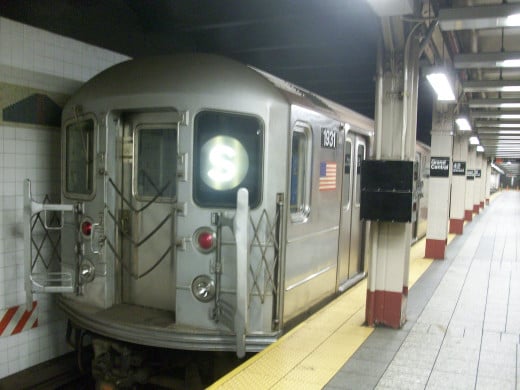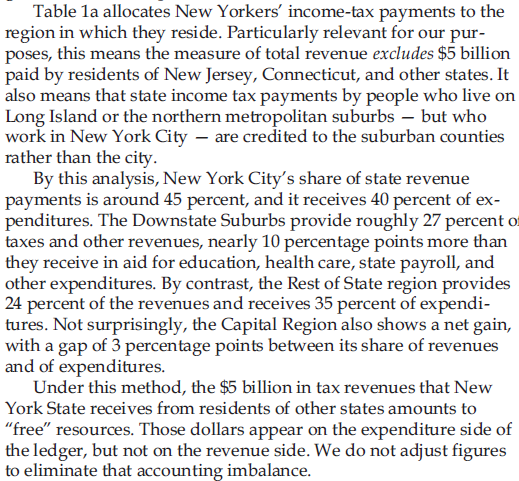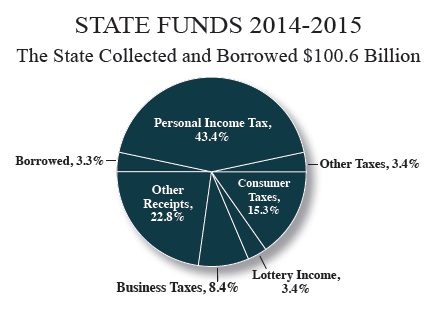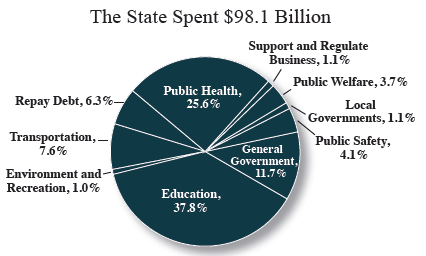Who is responsible for paying for the MTA, New York City or New York State?
What is the MTA?
The Metropolitan Transportation Authority (MTA) is a public benefit corporation chartered by the State of New York. They are responsible for public transportation in 12 counties in southeastern New York, and two counties in southwestern Connecticut.
The MTA moves over 11 million people per weekday, in addition to maintaining seven bridges and two tunnels which carry an over 800,000 vehicles per weekday.

History
The agency was chartered by the New York State Legislature in 1965 as the Metropolitan Commuter Transportation Authority (MCTA).
Governor Nelson Rockefeller created it to purchase and operate the bankrupt Long Island Rail Road. In 1968, the agency acquired the New York City Transit Authority (NYCTA) and Triborough Bridge and Tunnel Authority (TBTA) and dropped the word "Commuter" from its name, becoming the Metropolitan Transportation Authority (MTA) we know it as today.
In 1983 the MTA took over the Pennsylvania Railroad commuter lines: Hudson, Harlem and New Haven and consolidated them all as the Metro-North Commuter Railroad.
Governance
The MTA is governed by a 19-member board representing the 5 boroughs of New York City and each of the counties in its New York State service area.
Five members, in addition to the Chairman and CEO, are directly nominated by the Governor of New York, with four recommended by New York City’s mayor, and one each by the county executives of Nassau, Suffolk and Westchester counties. Each of these members has one vote.
The county executives of Dutchess, Orange, Rockland, and Putnam counties also nominate one member each, but these members cast one collective vote. The Board also has six rotating nonvoting seats held by representatives of MTA employee organized labor and the Permanent Citizens Advisory Committee, which serves as a voice for users of MTA transit and commuter facilities.
All board members are confirmed by the New York State Senate.
Sounds like the MTA only serves the City...
In that case, who is supposed to be paying for it?
Who pays for the MTA?
For the rest of this article, to facilitate ease of discussion I am going to ignore the two counties in Connecticut. Sorry about that, Fairfield and New Haven, but you'll still get Metro North service!
There is a disconnect in New York State which, while it does have six distinct regions with varying characters (and even climates), can basically be broken down to New York City area, New York City-surrounding area, and a non-New York City area. These three areas have approximately equal populations.
The dispute over who should pay for the MTA is driven by what some in the New York City area see as their right and what should be provided by the state, and what others outside of the service region see as freeloading since the statewide taxpayers are supporting it, but only the city-area residents are utilizing the public good.
But some non-New York City area politicians and citizens decry any additional State spending for what they see as a local issue.
Officials across the state have argued for “parity” between the downstate mass transit system and the rest of the State's Department of Transportation.
State Sen. Tom O'Mara, a Republican from the Southern Tier (a region of south-central New York State bordering --and threatening to secede to-- Pennsylvania), short-sightedly states, “To talk about capital needs for just one segment of our transportation infrastructure is not fair to the rest of the state. Our roads and bridges are every bit as important to us, our livelihood and our economy as the MTA is to New York City.”
This is indicative of the problem wherein people see the MTA as a City issue and only thinks it serves the City, completely ignoring that the City and the surrounding region are the majority of the State in terms of population, and in terms of tax base.
MTA Demographics
Population
| Services
| Bridges and Tunnels
| |
|---|---|---|---|
New York County (Manhattan)
| 1,636,268
| New York City Transit, Regional Bus Operations
| Triborough Bridge, Henry Hudson Bridge, Brooklyn-Battery Tunnel, Queens-Midtown Tunnel
|
Kings County (Brooklyn)
| 2,621,793
| New York City Transit
| Verrazano-Narrows Bridge, Marine Parkway–Gil Hodges Memorial Bridge, Brooklyn-Battery Tunnel
|
Queens County
| 2,321,580
| New York City Transit
| Triborough Bridge, Bronx–Whitestone Bridge, Throgs Neck Bridge, Marine Parkway–Gil Hodges Memorial Bridge, Cross Bay Veterans Memorial Bridge, Queens-Midtown Tunnel
|
Bronx County
| 1,438,159
| New York City Transit
| Triborough Bridge, Bronx-Whitestone Bridge, Throgs Neck Bridge, Henry Hudson Bridge
|
Richmond Count (Staten Island)
| 473,279
| Staten Island Railway, Bridges and Tunnels
| Verrazano-Narrows Bridge
|
Total New York City
| 8,491,079
| ||
Nassau County
| 1,339,532
| Long Island Rail Road
| |
Suffolk County
| 1,502,968
| Long Island Rail Road
| |
Total Long Island
| 2,842,500
| ||
Westchester County
| 949,113
| Metro-North Railroad
| |
Rockland County
| 311,687
| Metro-North Railroad
| |
Orange County
| 376,099
| Metro-North Railroad
| |
Putnam County
| 99,710
| Metro-North Railroad
| |
Dutchess County
| 297,488
| Metro-North Railroad
| |
Total Downstate
| 2,034,097
| ||
Total New York State MTA Counties
| 13,367,676
|
These bridges and tunnels have tolls ranging from a few dollars for motorcycles to an average of around $5 for a resident (of the immediate area, not NYC or the MTA region) to $5-16 for cars and $10-32 for trucks.
New York State's total population is 19,670,261, so the question is almost moot. The majority of New York State taxpayers are MTA-served, so the "us-vs.-them" rhetoric falls flat.
With a total population of 13,367,676 (exclusive of Fairfield and New Haven counties in Connecticut) the majority of the state of New York lives in a county with one or more varieties of MTA service.
62 Total NYS counties = 19,670,261
12 MTA counties = 13,367,676
50 non-MTA counties = 6,302,585
A mere 32% of the population thinks they are paying for something that they perceive a minority is benefiting from, when the majority are the beneficiaries, and in fact, it is this MTA-served population which is subsidizing infrastructure for the 32%.
The MTA serves 68% of the population...
So is the City now overpaying for the agency?
The MTA is a state agency but keeps asking for City money
The State of New York puts forth almost all of the MTA's budget, both for its capital and operating expenses. This seems like a lot of effort and expenditure for a large state to benefit only city, what about all the other regions?
Due to state underfunding, the MTA runs on deficit spending. Almost all of its fare increases are not to support its operating budget, but to help it pay back its debt due. The MTA held $31 billion in debt in 2010. The capital budget, which covers repairs, technological upgrades, new trains, and expansions, is currently $15 billion short and without state funding there is no way for the MTA to responsibly raise more debt. It will be a devastating impact to New Yorkers to raise the fare for a fifth time in as many years, but if this is not funded, the MTA will need to fund the repairs with debt and raise fares to cover repayments.
The financial burden of this necessary borrowing was exacerbated by the 00s decade economic downturn, which made it all the more obvious that the MTA cannot be supported solely by rider fares and road tolls. In light of this, the city had been giving the MTA a token $100 million a year, despite what city taxpayers already pay in fares. The MTA, getting nothing from the state, asked for more and Mayor Bill de Blasio and the New York City Council complied.
The city would now give the MTA $657 million and $125 million a year while the state ignored a $15 billion dollar budget gap. Immediately after this increase in funding from NYC, the MTA chairman Tom Prendergast (who is handpicked by Governor Andrew Cuomo) demanded more. The very morning of the city's announcement to acquiesce to the MTA's request, Prendergast said the city needed to give $1.5 billion and $300 million a year for the agency to remain afloat. And Albany said nothing.
New York City Finances New York State
New Yorkers already pay for the MTA directly in fares and tolls that cannot be avoided, but this is besides the point.
The argument that the state is subsidizing city-dwellers by paying for the MTA is laughable.
The city pays above and beyond its portion to the State and, on top of that, gets less than its due portion back.
The Nelson A. Rockefeller Institute of Government published a report in 2010 about tax sources and spending in New York State. The full study can be found here.
Please note that the following chart does not include the same regions as my data from above, as the Institute took a more narrow focus of the "Downstate Suburbs". Since the MTA service area was not a focus of their study, Orange and Dutchess counties are among the "rest of state", and the only suburbs included in the data are Nassau, Suffolk, Westchester, Rockland, and Putnam counties.
Regional distribution of New York State revenues and spending

What this shows is that the New York City and Downstate Suburbs are together account for 64.6% of the population (and the 673,587 in Orange and Dutchess Counties are included in Rest of State, making the figures slightly different than above).
But, this 64.6% of population pays 72.5% of all the taxes received by New York State and gets only 57.7% of the state's service expenditures.
(The Rockefeller Institute data also points out a heavily disproportionate per capita spending in the Albany region, but that is a different topic.)
This isn't all. Aside from county of residence, the following excerpt shows that this data seriously undercounts the tax effect that New York City has on the state's economy because of the number of people who work there but don't live there. People who need the MTA.

New York City area pays 72.5% of tax but gets 57.7% of service...
Is New York City overpaying its share of the State burden?
Effects of MTA's Budget Deficit
The MTA seriously needs the state's intervention and help, it cannot rely on the city - a much smaller entity - to float it alone.
This budget deficit has resulted in problems that are primarily concentrated in New York City.
New York City Subway fares have been increased four times since 2008, facing increasing resistance by MTA customers each time, with many of those hurt the hardest finding the fare increases prohibitive to the service.
Now, with subway ridership at an all-time high, the MTA is forced to cut service. There are fewer trains on most lines, which results in heavy overcrowding during rush hours, and normal service.
MTA employees also suffered due to the budget issues, with roughly 1,000 layoffs a year since 2010. Many of which were low-level employees who made $55,000 or less.
So what does the disproportionate amount of taxes paid by MTA takers have to do with the current budget deficit?
As we have seen, the New York City area pays the lionshare of taxes for the State. And of these taxes, the most disproportionately high in the State are those collected by those who earn in New York City. Both because of the significantly higher wages and the fact that the Personal Income Tax (PIT) is itself 43.4% of all taxes collected.
And from this vast sum of billions, only 7.6% is spent on transportation - of which a much smaller fraction is spent on the MTA.


Does New York State already pay its fair share for the MTA?
Does New York State already pay its fair share for the MTA?
New York State Will do Anything to not Pay for the MTA
In late October 2015, Governor Cuomo and Mayor de Blasio reached a compromise on capital funding for the Metropolitan Transportation Authority
After revising their Capital Plan from a $32B to $29B to $26B five-year plan, the MTA still had a ~$10 billion hole and Cuomo agreed to give the MTA $8.3 billion if the City would pay in $2.5 billion. Even though the head of the MTA himself only asked the city for $300 million as a contribution a mere few months prior.
Now the question is who is actually going to pay for the $10B total? As New York City residents are also citizens of the State, they may have to pay twice. Or, as they pay higher in general, they may be paying a double-share first (to the state) and then a single share once, thus paying three times what a citizen in Albany or Syracuse might pay to drive the single most important aspect of the State's economy.
Cuomo will likely have to borrow this amount – but $8.3 billion would add ~15% percent to the state’s debt load of $55 billion. Can the State afford that?
Well, at the end of the summer of 2015, the State had a windfall surplus of $6 billion -- from legal settlements with banks and businesses sued by the Attorney General, Eric Schneiderman. That was when Cuomo insisted de Blasio and New York City pay the whole $15B pricetag themselves somehow, so the Governor and the Legislature chose to allot almost all of it to subsidizing broadband Internet access upstate... and giving the MTA $250 million. Cuomo knew there was an immediate need to finance the capital plan, and sitting on a pile of money contributed a mere one-sixtieth of the amount needed.
And that's not all, Cuomo also rejects any plan that may either alleviate congestion and stress on the MTA's services or offer any new revenue streams, the most notable being the Move NY plan. Which would add tolls on drivers crossing the East River Bridges and heading south of 60th St. in Manhattan, while lowering them on other major arteries that are better equipped to handle heavy volumes. This would reduce overall traffic (and its attendant pollution) and generate $1.5 billion a year that could be diverted to the MTA as a stable source of revenue.
As this and other plans are shot down, Cuomo seems intent to leave the system a bigger mess than it was when he first took office. Infrastructure improvements on one of the oldest mass transit systems in the world are vastly needed and instead of doing right for the plurality of his constituents and the driving engine of his tax base, Cuomo ignores the problem and forces the MTA to be in crisis every five years, incapable of making any true longterm plans.
Second Avenue Subway, anybody?
© 2015 Jeramey Conrad








